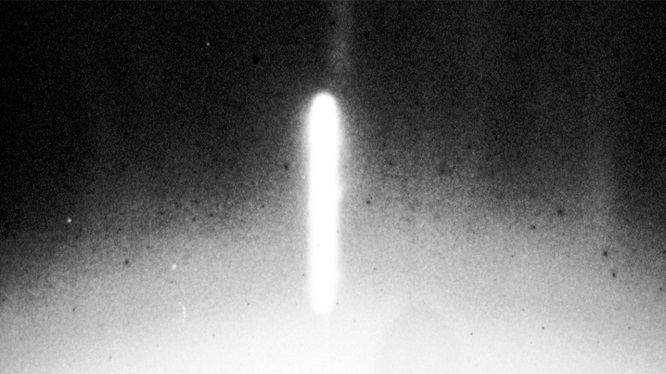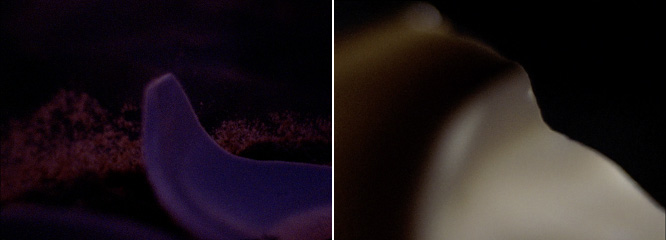
|
Panorama-cinéma is back at TIFF after a four-year absence! Our columnist Mike Hoolboom, one of the most famous and lovely experimental filmmakers in the country, will share his thoughts about some films from the Festival lineup. Don't miss this chance to attend the event by proxy, but mostly to bask in Mike's unique and rousing verve, which will undoubtedly manage to fill your mind with images both inspiring and horrendous, as if you were attending the crowded Lightbox screenings in person. — Olivier Thibodeau, editor Festivals section |

:: It follows It passes on (2023) [Erica Sheu]
My favourite movies used to be the ones that behaved like shy kids at a party. They would lurk around the edges, shining with repression and the infinite promise of unspoken thoughts. These movies would always be short, which meant that they could only be seen in programs of other shorts. They would do as much as possible not to draw attention to themselves, dissolving into the louder, emphatic callings that surrounded them.
It follows It passes on by Erica Sheu is a grainy 16 mm miniature. Set to the trill of a softly broken circuit with occasional guitar strums (as if the player was distracted, multitasking, adrift), the camera pans in close-up over a series of mysterious objects, parts of a hidden world, beneath notice and before language. Abstract shapes slowly throb, the artist plucks a film frame from a field of oatmeal with the finger of a giant. A candle, an aluminum scrap reflecting light, a riot of lens flares. Shadows cross suddenly flowing surfaces. Many of these encounters offer a rippled edge, as if each was a pointer signalling the right direction. It feels that the camera is not directing, but following the trail. And how do you make a trail? You walk the walk. You touch it and let it touch you.
The movie opens with a golden candle holder glimpsed through refracting glass. Brief titles appear noting the Taiwanese island of Kinmen, where a family walks across a beachfront, after the war, no longer needing to hide from bombs. These brief passages provide a frame for the soft abstractions that follow, marking them as moments of trauma and restoration, a world of charged supernal objects, containing family histories of death and nation.
The Chinese Civil War ended after decades of fighting in 1949, when the old leadership retreated to form a new government in Taiwan, while the Communist Party took control over mainland China. But the war has had a long tail, with smaller wars breaking out across the decades, along with the persistent threat of invasion. The war that endures after the war is over is the subject of this film. The wounds of seeing, the traumas that can imbue objects with a fantastical power. These private glances, collected in small rooms, spin a tale of family and borders, a curious private/public embrace showing the enduring cost of surviving. In her note about the film, the artist quotes Canadian poet Anne Carson who writes, “A wound gives off its own light.” [1] Here, the wound stretches across a whole country. It is the filmmaker’s duty to follow it, to create a world of elegy and grieving that is also a hymn to new ways of seeing.

[Erica Sheu]
Erica Sheu names herself an “experimental filmmaker,” a term many use to denote a historical period in the 1970s and 1980s. She’s part of the Rearflex Taiwanese Film Collective, where friends hang out and present work. The first program was called “Making Kin(o)!,” imagining that making films is also a way of making community, of bringing lives together.
“Auteurism matters, so does co-creation (collaboration). Experimental film is not just a lonely journey of materiality or the cinema language. Experimentation is also crucial. Co-creation can be an occasional escape from the individualism of artistic context, or from the professionalism and efficiency of the labour division in commercial filmmaking modules. What makes it experimental is how friendships, conflicts, inter-inspiring, fun and playfulness transform the process.” [2]
Their manifesto is filled with evocations of self-care, the need to take it slow, emphasizing that artists should be free to form other groups and alliances if they want. The whole approach is a soft touch, a fluffy blanket of invitation. The group shares works-in-progress, along with movies by analog film labs and travelling filmmakers. Sincerity, youth, belief, collective aspirations. Even the manifesto arrives with a parenthetical question mark. Here there is a need not only to make work, but to create a context for it, to make a group out of the radical interiority of each of its members. Here, in the shadow of one of the world’s great superpowers, even friendship has become political, even outmoded ways of making film, and sharing them. If filmmaking is necessarily film exhibition, community cannot be separated from the subjectivity it helps create, and the art that nourishes it.
[1] Anne Carson, The Beauty of the Husband: A Fictional Essay in 29 Tangos (New York: Alfred A. Knopf, 2001), 5.
[2] Rearflex Taiwanese Film Collective, “Making Kin(((o)))! — a manifesto (?)” (September 2021), https://rearflexpfilm.cargo.site/manifesto
*
Mike Hoolboom began making movies in 1980. Making as practice, a daily application. Ongoing remixology. Since 2000 there has been a steady drip of found footage bio docs. The animating question of community: how can I help you? Interviews with media artists for 3 decades. Monographs and books, written, edited, co-edited. Local ecologies. Volunteerism. Opening the door.

 |
envoyer par courriel | 
| imprimer | Tweet |
